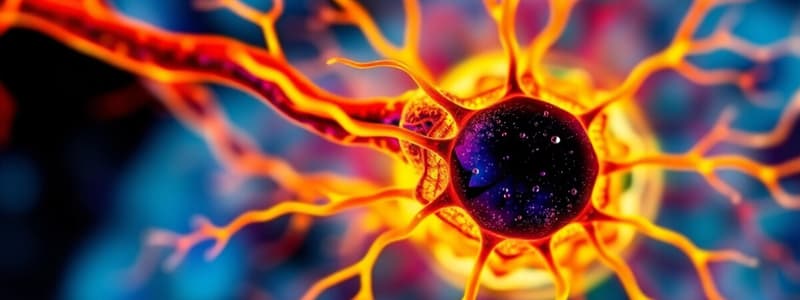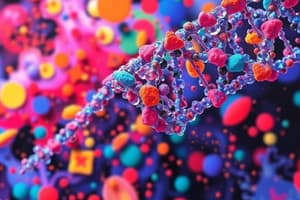Podcast
Questions and Answers
What process do cells use to maintain conditions for life?
What process do cells use to maintain conditions for life?
- Cell division
- Photosynthesis
- Protein synthesis
- Metabolism (correct)
What is the primary function of the cell membrane?
What is the primary function of the cell membrane?
- To isolate chemical reactions from the external environment (correct)
- To provide energy to the cell
- To facilitate cell division
- To synthesize proteins
Which type of microscopy is best for studying organelles?
Which type of microscopy is best for studying organelles?
- Electron microscopy (correct)
- Conventional compound light microscopy
- Fluorescence microscopy
- Phase contrast microscopy
What is a distinguishing characteristic of neurons compared to other cells?
What is a distinguishing characteristic of neurons compared to other cells?
Which of the following is a method used in microscopy to enhance tissue visibility?
Which of the following is a method used in microscopy to enhance tissue visibility?
What role do glial cells play in the nervous system?
What role do glial cells play in the nervous system?
What is the typical thickness of a cell membrane?
What is the typical thickness of a cell membrane?
Which cellular components are embedded within the phospholipid bilayer of the cell membrane?
Which cellular components are embedded within the phospholipid bilayer of the cell membrane?
What is the primary function of the nucleolus within the nucleus?
What is the primary function of the nucleolus within the nucleus?
How many pairs of chromosomes do humans have?
How many pairs of chromosomes do humans have?
What is the correct sequence of synthesis indicated by the information provided?
What is the correct sequence of synthesis indicated by the information provided?
What type of molecule is DNA primarily composed of?
What type of molecule is DNA primarily composed of?
What condition is caused by an extra copy of chromosome 21?
What condition is caused by an extra copy of chromosome 21?
Which term refers to the instructions encoded for protein synthesis?
Which term refers to the instructions encoded for protein synthesis?
The specific sequence of how many nucleotides in mRNA dictates the amino acid that is assembled into a protein?
The specific sequence of how many nucleotides in mRNA dictates the amino acid that is assembled into a protein?
What determines the function of a cell according to the information provided?
What determines the function of a cell according to the information provided?
What is the primary function of mitochondria in neurons?
What is the primary function of mitochondria in neurons?
Which organelle is primarily responsible for breaking down organelles and recycling molecules in neurons?
Which organelle is primarily responsible for breaking down organelles and recycling molecules in neurons?
What are the three main elements of the cytoskeleton?
What are the three main elements of the cytoskeleton?
Where does most protein synthesis occur in a neuron?
Where does most protein synthesis occur in a neuron?
What is the process of synthesizing mRNA from DNA called?
What is the process of synthesizing mRNA from DNA called?
What type of transport is fastest in axonal transport?
What type of transport is fastest in axonal transport?
Where does protein synthesis primarily occur in neurons?
Where does protein synthesis primarily occur in neurons?
Which motor proteins are involved in retrograde axonal transport?
Which motor proteins are involved in retrograde axonal transport?
What is the primary function of ribosomes in protein synthesis?
What is the primary function of ribosomes in protein synthesis?
What is the speed range of slow anterograde transport in neurons?
What is the speed range of slow anterograde transport in neurons?
What distinguishes rough endoplasmic reticulum from smooth endoplasmic reticulum?
What distinguishes rough endoplasmic reticulum from smooth endoplasmic reticulum?
What role do intermediate filaments play in neurons?
What role do intermediate filaments play in neurons?
What is Nissl substance primarily composed of?
What is Nissl substance primarily composed of?
What is the role of the Golgi apparatus in protein processing?
What is the role of the Golgi apparatus in protein processing?
Which part of the neuron is not typically associated with high amounts of rough ER?
Which part of the neuron is not typically associated with high amounts of rough ER?
What type of organelle is primarily involved in the transport of proteins within the cell?
What type of organelle is primarily involved in the transport of proteins within the cell?
What is the primary function of astrocytes in the CNS?
What is the primary function of astrocytes in the CNS?
How does rabies infect the central nervous system?
How does rabies infect the central nervous system?
Which type of cell is responsible for myelinating axons in the CNS?
Which type of cell is responsible for myelinating axons in the CNS?
What role do microglia play in the nervous system?
What role do microglia play in the nervous system?
How do Schwann cells function in the PNS?
How do Schwann cells function in the PNS?
What characterizes herpes simplex type II?
What characterizes herpes simplex type II?
Which of the following is NOT a function of astrocytes?
Which of the following is NOT a function of astrocytes?
What is the primary function of ependymal cells in the CNS?
What is the primary function of ependymal cells in the CNS?
Study Notes
Review Session
- First review session scheduled for Tuesday, September 16 from 4-5 PM in Room MCB 3-146.
- Opportunity to ask questions and practice knowledge without introducing new material.
Cells
- All life consists of cells that perform complex chemical reactions, known as metabolism, for growth and reproduction.
- Cells are enclosed by a cell membrane that maintains internal conditions necessary for life and regulates ion transport.
Cell Types in Nervous System
- Distinction between two main cell types: neurons and glia.
- Neurons vary in shape (small, medium, large; pyramidal, stellate, granular) and function, including signal transmission and myelin sheath creation.
Microscopy Techniques
- Classic histology involves tissue treatment and dissection for examination.
- Various microscopy techniques are used:
- Conventional light microscopy allows low to high magnification.
- Fluorescence microscopy reveals molecules within samples.
- Electron microscopy provides detailed studies of organelles using metal staining.
Neuron Structure
- Neurons possess organelles, including a nucleus and mitochondria, but have specialized functions in comparison to other cells.
Cell Membrane
- The cell membrane is a phospholipid bilayer, 6-8 nanometers thick, ensuring cell functioning is maintained.
Nucleus Structure
- Central organelle consisting of a nuclear membrane, chromosomes, and nucleolus; pivotal for genetic information storage.
Chromosomes and Genes
- Humans have 23 pairs of chromosomes; abnormality in the 21st chromosome leads to Down syndrome.
- DNA consists of sequences of four nucleotides, with approximately 23,000 genes influencing protein synthesis.
Protein Synthesis
- Transcription in the nucleus synthesizes mRNA from DNA; translation in the cytoplasm produces proteins.
- Only specific proteins are expressed in different cell types, determining their functions.
Organelles Overview
- Ribosomes synthesize proteins in the cell, either freely or attached to the rough endoplasmic reticulum.
- Rough ER is significant in synthesizing membrane and export proteins, termed Nissl substances in neurons.
- Golgi apparatus modifies and packages proteins from the rough ER into vesicles for transport.
Mitochondria and Lysosomes
- Mitochondria generate cell energy and are present throughout the neuron.
- Lysosomes recycle cellular components through enzymes.
Cytoskeleton
- Comprises microtubules, intermediate filaments, and microfilaments, providing structural support and aiding in transport and movement within the cell.
Axonal Transport
- Most protein synthesis occurs in neuron cell bodies, with minimal mRNA in axons.
- Axonal transport is crucial for moving organelles and molecules; kinesins transport in the anterograde direction, while dyneins handle retrograde transport.
Axonal Transport Rates
- Fast anterograde transport is 100-400 mm/day, moving materials to axon terminals.
- Slow transport is 0.25-5 mm/day, facilitating the movement of structural components.
Viral Transport Mechanisms
- Rabies virus travels retrogradely along nerves to infect central nervous system cells.
- Herpes simplex has lifelong residence in sensory neuron somas after initial infection.
Glial Cells
- Non-neuronal cells support and protect neurons, including astrocytes, oligodendrocytes, ependymal cells, and microglia in the CNS; Schwann cells and satellite cells in the PNS.
Astrocytes
- Star-shaped, abundant glial cells that play key roles in supporting neurons and maintaining the blood-brain barrier.
Oligodendrocytes
- Wrap around axons in the CNS to enhance signal conduction through myelination.
Microglia
- Act as the brain's immune cells, managing development, maintenance, and injury response.
Studying That Suits You
Use AI to generate personalized quizzes and flashcards to suit your learning preferences.
Related Documents
Description
Join us for a comprehensive review session focusing on cell biology and microscopy techniques. This session will cover the fundamental concepts of cell structure, function, and the types of cells in the nervous system. Additionally, we will explore various microscopy techniques used in histology.




